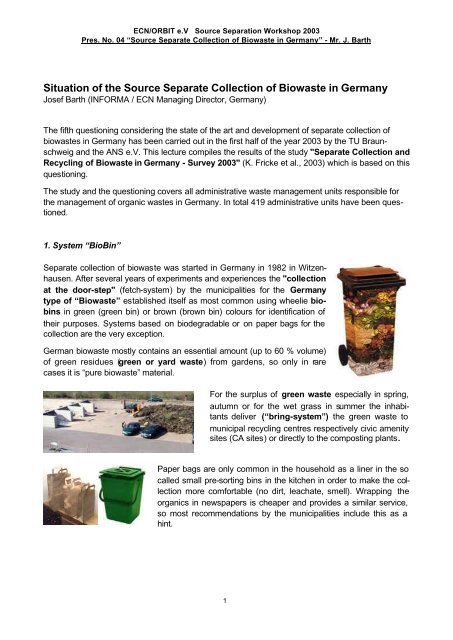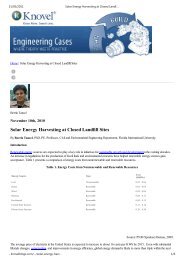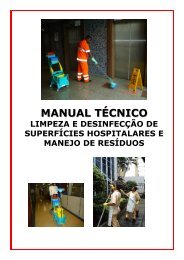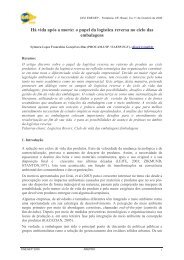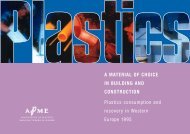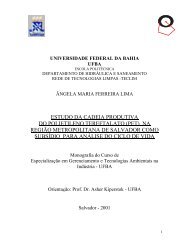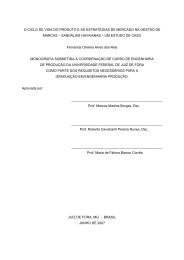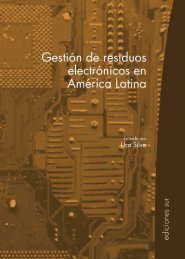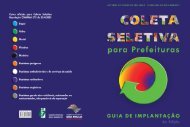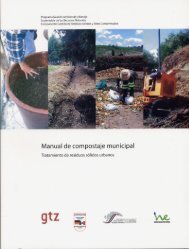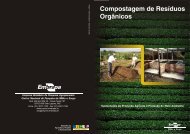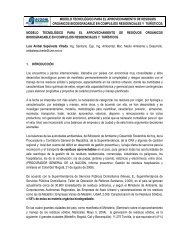Situation of the Source Separate Collection of Biowaste in Germany
Situation of the Source Separate Collection of Biowaste in Germany
Situation of the Source Separate Collection of Biowaste in Germany
You also want an ePaper? Increase the reach of your titles
YUMPU automatically turns print PDFs into web optimized ePapers that Google loves.
ECN/ORBIT e.V <strong>Source</strong> Separation Workshop 2003<br />
Pres. No. 04 “<strong>Source</strong> <strong>Separate</strong> <strong>Collection</strong> <strong>of</strong> <strong>Biowaste</strong> <strong>in</strong> <strong>Germany</strong>” - Mr. J. Barth<br />
<strong>Situation</strong> <strong>of</strong> <strong>the</strong> <strong>Source</strong> <strong>Separate</strong> <strong>Collection</strong> <strong>of</strong> <strong>Biowaste</strong> <strong>in</strong> <strong>Germany</strong><br />
Josef Barth (INFORMA / ECN Manag<strong>in</strong>g Director, <strong>Germany</strong>)<br />
The fifth question<strong>in</strong>g consider<strong>in</strong>g <strong>the</strong> state <strong>of</strong> <strong>the</strong> art and development <strong>of</strong> separate collection <strong>of</strong><br />
biowastes <strong>in</strong> <strong>Germany</strong> has been carried out <strong>in</strong> <strong>the</strong> first half <strong>of</strong> <strong>the</strong> year 2003 by <strong>the</strong> TU Braunschweig<br />
and <strong>the</strong> ANS e.V. This lecture compiles <strong>the</strong> results <strong>of</strong> <strong>the</strong> study "<strong>Separate</strong> <strong>Collection</strong> and<br />
Recycl<strong>in</strong>g <strong>of</strong> <strong>Biowaste</strong> <strong>in</strong> <strong>Germany</strong> - Survey 2003" (K. Fricke et al., 2003) which is based on this<br />
question<strong>in</strong>g.<br />
The study and <strong>the</strong> question<strong>in</strong>g covers all adm<strong>in</strong>istrative waste management units responsible for<br />
<strong>the</strong> management <strong>of</strong> organic wastes <strong>in</strong> <strong>Germany</strong>. In total 419 adm<strong>in</strong>istrative units have been questioned.<br />
1. System “BioB<strong>in</strong>”<br />
<strong>Separate</strong> collection <strong>of</strong> biowaste was started <strong>in</strong> <strong>Germany</strong> <strong>in</strong> 1982 <strong>in</strong> Witzenhausen.<br />
After several years <strong>of</strong> experiments and experiences <strong>the</strong> "collection<br />
at <strong>the</strong> door-step" (fetch-system) by <strong>the</strong> municipalities for <strong>the</strong> <strong>Germany</strong><br />
type <strong>of</strong> “<strong>Biowaste</strong>” established itself as most common us<strong>in</strong>g wheelie biob<strong>in</strong>s<br />
<strong>in</strong> green (green b<strong>in</strong>) or brown (brown b<strong>in</strong>) colours for identification <strong>of</strong><br />
<strong>the</strong>ir purposes. Systems based on biodegradable or on paper bags for <strong>the</strong><br />
collection are <strong>the</strong> very exception.<br />
German biowaste mostly conta<strong>in</strong>s an essential amount (up to 60 % volume)<br />
<strong>of</strong> green residues (green or yard waste) from gardens, so only <strong>in</strong> rare<br />
cases it is “pure biowaste” material.<br />
For <strong>the</strong> surplus <strong>of</strong> green waste especially <strong>in</strong> spr<strong>in</strong>g,<br />
autumn or for <strong>the</strong> wet grass <strong>in</strong> summer <strong>the</strong> <strong>in</strong>habitants<br />
deliver (“br<strong>in</strong>g-system”) <strong>the</strong> green waste to<br />
municipal recycl<strong>in</strong>g centres respectively civic amenity<br />
sites (CA sites) or directly to <strong>the</strong> compost<strong>in</strong>g plants.<br />
Paper bags are only common <strong>in</strong> <strong>the</strong> household as a l<strong>in</strong>er <strong>in</strong> <strong>the</strong> so<br />
called small pre-sort<strong>in</strong>g b<strong>in</strong>s <strong>in</strong> <strong>the</strong> kitchen <strong>in</strong> order to make <strong>the</strong> collection<br />
more comfortable (no dirt, leachate, smell). Wrapp<strong>in</strong>g <strong>the</strong><br />
organics <strong>in</strong> newspapers is cheaper and provides a similar service,<br />
so most recommendations by <strong>the</strong> municipalities <strong>in</strong>clude this as a<br />
h<strong>in</strong>t.<br />
1
ECN/ORBIT e.V <strong>Source</strong> Separation Workshop 2003<br />
Pres. No. 04 “<strong>Source</strong> <strong>Separate</strong> <strong>Collection</strong> <strong>of</strong> <strong>Biowaste</strong> <strong>in</strong> <strong>Germany</strong>” - Mr. J. Barth<br />
<strong>Collection</strong> is done exclusively done by<br />
wheelie b<strong>in</strong>s from 80 to 240 litres<br />
where <strong>the</strong> 120 litre volume is <strong>the</strong><br />
most common. In high rise build<strong>in</strong>g<br />
several household use small conta<strong>in</strong>ers<br />
(> 1 cbm) toge<strong>the</strong>r.<br />
Fortnightly <strong>in</strong>tervals for <strong>the</strong> collection are favoured on account <strong>of</strong> cost<br />
reasons. The collection days are mentioned <strong>in</strong> “Recycl<strong>in</strong>g Calenders” for <strong>the</strong><br />
households which <strong>of</strong>ten <strong>in</strong>clude lists what is allowed to be put <strong>in</strong> <strong>the</strong> biob<strong>in</strong><br />
and what is forbidden.<br />
Fears that a 14-day stand<strong>in</strong>g time <strong>of</strong> <strong>the</strong> b<strong>in</strong>s might create an <strong>in</strong>tolerable<br />
amount <strong>of</strong> smells, maggots, flies and create health problems have so far not<br />
been confirmed <strong>in</strong> <strong>Germany</strong>. Experiences show that after a certa<strong>in</strong> period<br />
<strong>the</strong> <strong>in</strong>habitants get accustomed to <strong>the</strong> biob<strong>in</strong> and learn to manage it, even <strong>in</strong><br />
<strong>the</strong> hot summertime where some odour, maggots and flies occur e.g. by<br />
add<strong>in</strong>g newspaper. Never<strong>the</strong>less a lot <strong>of</strong> local authorities try to avoid compla<strong>in</strong>ts<br />
by <strong>the</strong> <strong>in</strong>habitant and organise a weekly collection <strong>in</strong> <strong>the</strong> summer<br />
months.<br />
Packer trucks (revolv<strong>in</strong>g-drum or compression-plate vehicles)<br />
are standard for <strong>the</strong> collection <strong>of</strong> biowaste at <strong>the</strong> doorstep.<br />
Revolv<strong>in</strong>g-drum vehicles have <strong>the</strong> advantage that <strong>the</strong><br />
compost material is thoroughly mixed dur<strong>in</strong>g collection which<br />
is advantageous for subsequent decomposition and for a<br />
smaller amount <strong>of</strong> odorous leachate <strong>in</strong> <strong>the</strong> vehicle.<br />
Side-loaders become more and more common. Reduced<br />
costs for staff and a lower burden for <strong>the</strong> collection personnel<br />
are <strong>the</strong> ma<strong>in</strong> advantages.<br />
2. Status quo<br />
In 2002 <strong>the</strong> separately biowaste collection was <strong>in</strong>troduced <strong>in</strong> 81 % <strong>of</strong> <strong>the</strong> adm<strong>in</strong>istrative units 4 %<br />
more compared with 1997. Related to <strong>the</strong> population equivalent <strong>in</strong> <strong>the</strong> areas <strong>of</strong> <strong>the</strong> biowaste collection<br />
an average participation rate (= amount <strong>of</strong> <strong>in</strong>habitant with <strong>the</strong>oretical access to separate collection)<br />
<strong>of</strong> approximately 61 % could be registered <strong>in</strong> 2002. The not that high participation rate <strong>in</strong><br />
<strong>Germany</strong> proves a considerable potential <strong>of</strong> <strong>the</strong> development <strong>of</strong> <strong>the</strong> separate collection <strong>of</strong> biowastes<br />
<strong>in</strong> <strong>Germany</strong>.<br />
Most <strong>of</strong> <strong>the</strong> adm<strong>in</strong>istrative units established <strong>the</strong> biowaste collection between <strong>the</strong> years 1991 and<br />
1997. Only <strong>in</strong> n<strong>in</strong>e units new <strong>in</strong>troductions took place between 1998 and 2002. Only 10% <strong>of</strong> <strong>the</strong><br />
adm<strong>in</strong>istrative units questioned showed an <strong>in</strong>terest <strong>in</strong> <strong>in</strong>creas<strong>in</strong>g <strong>the</strong>ir biowaste collection activities<br />
<strong>in</strong> <strong>the</strong> next years.<br />
2
ECN/ORBIT e.V <strong>Source</strong> Separation Workshop 2003<br />
Pres. No. 04 “<strong>Source</strong> <strong>Separate</strong> <strong>Collection</strong> <strong>of</strong> <strong>Biowaste</strong> <strong>in</strong> <strong>Germany</strong>” - Mr. J. Barth<br />
Table 1: Status quo separate collection <strong>of</strong> organic waste <strong>in</strong> <strong>Germany</strong> – Status 12.2002<br />
Participation rate <strong>of</strong> <strong>the</strong> adm<strong>in</strong>istrative units <strong>in</strong> separate<br />
collection <strong>of</strong> biowaste<br />
Average participation rate <strong>of</strong> <strong>the</strong> <strong>in</strong>habitants <strong>in</strong> <strong>the</strong><br />
adm<strong>in</strong>istrative units with separate biowaste collection<br />
Average capture rate (= amount <strong>of</strong> biowaste collected<br />
<strong>in</strong> reality compared with potential)<br />
1997 2002<br />
ca. 77 % ca. 81 %<br />
ca. 54 % ca. 61 %<br />
ca. 54 % ca. 59 %<br />
Inhabitants connected to source separation ca. 37 million Inh. ca. 39 million Inh.<br />
Collected amounts <strong>of</strong> biowaste 4.060.000 t/y 4.525.000 t/y<br />
Collected amounts <strong>of</strong> green waste<br />
Inhabitant related biowaste quantity based on <strong>the</strong><br />
connected part <strong>of</strong> <strong>the</strong> population<br />
Inhabitant related bio and green waste quantity based<br />
on <strong>the</strong> total population<br />
ca. 109 kg/ Inh + y<br />
3.807.000 t/y<br />
ca. 110 kg/Inh + y<br />
ca. 98 kg/ Inh + y<br />
The differences between <strong>the</strong> participation rates <strong>in</strong> <strong>the</strong> biowaste collection between <strong>the</strong> adm<strong>in</strong>istrative<br />
units are based on <strong>the</strong>ir differ<strong>in</strong>g waste management strategies visible In <strong>the</strong>ir municipal waste<br />
regulations when it comes to <strong>the</strong> b<strong>in</strong> fees and <strong>the</strong> degree <strong>of</strong> obligation to participate <strong>in</strong> <strong>the</strong> biob<strong>in</strong><br />
system.<br />
In 59 % <strong>of</strong> <strong>the</strong> adm<strong>in</strong>strative units a participation <strong>in</strong> <strong>the</strong> separate biowaste collection is obligatory.<br />
In nearly all adm<strong>in</strong>istrative units (90%) a release <strong>of</strong> <strong>the</strong> obligation <strong>of</strong> participation <strong>in</strong> <strong>the</strong> biobion<br />
system is given after provid<strong>in</strong>g prove <strong>of</strong> home compost<strong>in</strong>g <strong>of</strong> all organic wastes.<br />
82 % <strong>of</strong> <strong>the</strong> adm<strong>in</strong>istrative units promote home compost<strong>in</strong>g by giv<strong>in</strong>g advice <strong>in</strong> its management and<br />
a reduction <strong>of</strong> <strong>the</strong> organic waste fees between 30 and 100 %. Only <strong>in</strong> very rare cases <strong>the</strong> buy<strong>in</strong>g <strong>of</strong><br />
home compost<strong>in</strong>g equipment is sponsored.<br />
3. Waste quantities and composition<br />
The total amount <strong>of</strong> 4,5 million t/y <strong>of</strong> bio and 3,8 million t/y <strong>of</strong>) green wastes were collected <strong>in</strong> 2002<br />
<strong>in</strong> <strong>Germany</strong> - <strong>in</strong> total more than 8 million t/y.<br />
Dist<strong>in</strong>ct differences exist at <strong>the</strong> <strong>in</strong>habitant-specific quantities between <strong>the</strong> new and old Federal<br />
Countries. An average <strong>of</strong> 52 kg/Inhabitant/y are collected <strong>in</strong> <strong>Germany</strong>, approx. 60 kg/Inh/y (23 to<br />
46 kg/Inh/y) <strong>in</strong> <strong>the</strong> old Federal Countries and <strong>in</strong> <strong>the</strong> new Countries only 22 kg/Inh/y. Green wastes<br />
have a collection rate <strong>of</strong> 46 kg/I/a, 54 kg/I/a (between 29 and 85) <strong>in</strong> <strong>the</strong> old Countries and 17<br />
kg/Inh/y <strong>in</strong> <strong>the</strong> new Countries.<br />
The quantities <strong>in</strong> <strong>the</strong> adm<strong>in</strong>istrative units with <strong>in</strong>troduced biowaste collection are at 110<br />
kg/<strong>in</strong>habitant/y biowaste which reflects a capture rate <strong>of</strong> approx. 59 % (table 1).<br />
The quantities <strong>of</strong> residual wastes from households (<strong>in</strong>clud<strong>in</strong>g waste from <strong>of</strong>fices) shows 14.6 million<br />
t. This corresponds to a quantity <strong>of</strong> 177 kg/per <strong>in</strong>habitant and year.<br />
3
ECN/ORBIT e.V <strong>Source</strong> Separation Workshop 2003<br />
Pres. No. 04 “<strong>Source</strong> <strong>Separate</strong> <strong>Collection</strong> <strong>of</strong> <strong>Biowaste</strong> <strong>in</strong> <strong>Germany</strong>” - Mr. J. Barth<br />
If <strong>the</strong> organic part <strong>in</strong> <strong>the</strong> residual waste quantities, momentarily collected, is taken as a basis an<br />
ascerta<strong>in</strong>able collectable biowaste potential <strong>of</strong> 9.1 million t/y can be calculated..<br />
The low capture rates compared with o<strong>the</strong>r systems <strong>of</strong> separate collection, as e.g. for paper and<br />
glass, where values <strong>of</strong> about 80 % are achieved, show a large development respectively optimisation<br />
potential <strong>in</strong> <strong>the</strong> system <strong>of</strong> biowaste collection <strong>in</strong> <strong>Germany</strong>. Dist<strong>in</strong>ctly higher capture rates could<br />
be realised with <strong>the</strong> help <strong>of</strong> organisational measures (e.g. local municipal waste regulations) toge<strong>the</strong>r<br />
with high-level purposeful public relations work. This is demonstrated by biowaste collection<br />
capture rates between 70 and 81 % <strong>in</strong> several adm<strong>in</strong>istrative units.<br />
4. Impurities<br />
Only around 10 % <strong>of</strong> <strong>the</strong> adm<strong>in</strong>istrative units stated impurities (on account <strong>of</strong> wrong sort<strong>in</strong>g)<br />
above a level <strong>of</strong> 5%. These data <strong>of</strong>ten don’t correspond to usual statements, that <strong>the</strong> collected<br />
biowastes are massively contam<strong>in</strong>ated (table 2).<br />
Table 2: Frequency distribution <strong>of</strong> impurity loads <strong>in</strong> biowastes, values standardised to 100%<br />
Impurity loads Frequency (Status 2002)<br />
< 1,5% 20,4%<br />
1,6 bis 3% 35,8%<br />
3,1 bis 5% 32,8%<br />
> 5% 11.0%<br />
The composition <strong>of</strong> <strong>the</strong> impurities shows that <strong>the</strong>y are preponderantly caused by kitchen wastes <strong>in</strong><br />
<strong>the</strong> biowaste, <strong>in</strong> densely populated areas (e.g. high rise build<strong>in</strong>gs) and by socially weak groups.<br />
Therefore should measures for optimisation concentrate <strong>in</strong> <strong>the</strong> first <strong>in</strong>stance on <strong>the</strong>se groups.<br />
An extraord<strong>in</strong>ary role among <strong>the</strong> measures for <strong>the</strong> decrease <strong>of</strong> impurities is to be seen <strong>in</strong> public<br />
relations work. O<strong>the</strong>r measures are <strong>the</strong> visual control <strong>of</strong> <strong>the</strong> biob<strong>in</strong>s <strong>in</strong> areas with a high amount <strong>of</strong><br />
impurities, <strong>the</strong> distribution <strong>of</strong> "red cards" to “dirty b<strong>in</strong>” owners, stop <strong>of</strong> clearance <strong>of</strong> contam<strong>in</strong>ated<br />
b<strong>in</strong>s, stop <strong>of</strong> <strong>the</strong> collection at problematic locations and <strong>the</strong> <strong>in</strong>troduction <strong>of</strong> metal detection systems<br />
at <strong>the</strong> collection vehicles.<br />
5. Compost quality<br />
Regard<strong>in</strong>g <strong>the</strong> quality problems <strong>of</strong> <strong>the</strong> compost<strong>in</strong>g plants <strong>the</strong> adm<strong>in</strong>istrative units claimed problems<br />
with impurities and achievement <strong>of</strong> <strong>the</strong> decomposition degree.<br />
The development <strong>of</strong> <strong>the</strong> compost quality regard<strong>in</strong>g <strong>the</strong> heavy metal loads from 1989/90 to 1999<br />
shows that, except from copper, <strong>the</strong> heavy metal load has decreased. Reasons for <strong>the</strong> <strong>in</strong>crease <strong>of</strong><br />
<strong>the</strong> copper load are momentarily exam<strong>in</strong>ed by <strong>the</strong> Federal Environmental Agency.<br />
The most significant source for harmful <strong>in</strong>puts <strong>in</strong> <strong>the</strong> compost raw material is to be seen <strong>in</strong> <strong>the</strong> <strong>in</strong>put<br />
via air which contam<strong>in</strong>ate <strong>the</strong> vegetable compost raw material directly or <strong>in</strong>direct over <strong>the</strong> soil (primary<br />
source). These <strong>in</strong>put sources can not be <strong>in</strong>fluenced by waste management measures.<br />
4
ECN/ORBIT e.V <strong>Source</strong> Separation Workshop 2003<br />
Pres. No. 04 “<strong>Source</strong> <strong>Separate</strong> <strong>Collection</strong> <strong>of</strong> <strong>Biowaste</strong> <strong>in</strong> <strong>Germany</strong>” - Mr. J. Barth<br />
Table 3: Success <strong>of</strong> separate collection <strong>of</strong> biowaste concern<strong>in</strong>g <strong>the</strong> reduction <strong>of</strong> heavy metals <strong>in</strong><br />
composts, <strong>in</strong> mg/kg DM (KEHRES, 2003)<br />
Mixed waste<br />
compost (1984)<br />
<strong>Biowaste</strong> compost /<br />
Sep. collection (2003)<br />
Hobby garden<br />
compost<br />
Lead 513 46,4 40 - 60<br />
Cadmium 5,5 0,47 0,3 – 0,6<br />
Chrom 71,4 25,3 25 - 40<br />
Copper 274 57,7 40 - 60<br />
Nickel 44,9 16,3 15 - 25<br />
Mercury n.s. 0,16 0,1 – 0,2<br />
Z<strong>in</strong>k 1.570 203 180 - 240<br />
Mixed waste compost: LAGA Nr. 8, Merkblatt M 10, status 10/1984.<br />
<strong>Biowaste</strong> compost: Mean values <strong>in</strong> <strong>Germany</strong>, results <strong>of</strong> UBA/BGK-Study 2003.<br />
The measures for a reduction <strong>of</strong> <strong>the</strong> heavy metal loads can be directly <strong>in</strong>fluenced by source separation<br />
(table 3), <strong>the</strong> selection <strong>of</strong> suitable compost raw material and <strong>the</strong> m<strong>in</strong>imisation <strong>of</strong> <strong>the</strong> impurity<br />
contents. Qualities comparable to those <strong>of</strong> hobby garden composts can be reached. Suitable orig<strong>in</strong>al<br />
material is quoted <strong>in</strong> annex 1 <strong>of</strong> <strong>the</strong> German biowaste ord<strong>in</strong>ance. Only <strong>the</strong>se must be used.<br />
The concentration <strong>of</strong> heavy metals conta<strong>in</strong>ed <strong>in</strong> German compost corresponds to <strong>the</strong> <strong>in</strong>evitable<br />
natural background contents. The authors <strong>of</strong> <strong>the</strong> study state that an effective control <strong>of</strong> that <strong>in</strong>takes<br />
which can be operated <strong>in</strong> daily practice, e.g. exclusion <strong>of</strong> unsuitable biowastes, cannot be realized.<br />
6. Summary<br />
After 20 years <strong>the</strong> “biob<strong>in</strong>” collection system for separately collected organic waste from household<br />
and gardens has shown its effectiveness and is established <strong>in</strong> German municipal waste management<br />
and <strong>in</strong> <strong>the</strong> society.<br />
The collected quantity <strong>of</strong> biowastes could be <strong>in</strong>creased by an extension <strong>of</strong> <strong>the</strong> separate collection<br />
<strong>in</strong> fur<strong>the</strong>r adm<strong>in</strong>istrative units, <strong>in</strong>crease <strong>of</strong> <strong>the</strong> participation rate <strong>in</strong> <strong>the</strong> adm<strong>in</strong>istration units with exist<strong>in</strong>g<br />
biowaste collection and especially through a purposeful and qualitative high-level public relations<br />
work. If one takes <strong>the</strong> capture rate <strong>of</strong> 80 % as a basis, like this is <strong>the</strong> case with glass and paper,<br />
an additional quantity <strong>of</strong> up to 3 million t/y <strong>of</strong> biowastes could be collected. That this is possible<br />
demonstrate actually achieved capture rates <strong>of</strong> more than 80 % <strong>in</strong> some municipalities.<br />
The question<strong>in</strong>g showed, however, that at present an <strong>in</strong>crease <strong>of</strong> <strong>the</strong> biowaste collection <strong>in</strong> <strong>Germany</strong><br />
cannot be achieved. To what extent endeavours will be undertaken <strong>in</strong> future, will strongly<br />
depend on <strong>the</strong> develop<strong>in</strong>g costs for waste recycl<strong>in</strong>g compared to waste disposal and on policy.<br />
Consider<strong>in</strong>g compost, it can be said, that <strong>the</strong> avoidance potential for heavy metal m<strong>in</strong>imization controllable<br />
through waste management measures is by far exhausted. A decrease <strong>of</strong> <strong>the</strong> heavy metal<br />
load <strong>in</strong> <strong>Germany</strong> <strong>in</strong> <strong>the</strong> source material for compost<strong>in</strong>g can only be guaranteed <strong>in</strong> <strong>the</strong> long run<br />
through closure <strong>of</strong> primary sources for harmful matter <strong>in</strong>take, like e.g. airborne heavy metal <strong>in</strong>puts.<br />
The majority <strong>of</strong> <strong>the</strong> German population shows high commitments to take <strong>the</strong> waste problem "<strong>in</strong><br />
<strong>the</strong>ir own hands" and to provide valuable material through <strong>the</strong> separate collection for reuse - this is<br />
an executed environmental conscience.<br />
7. References<br />
Fricke, K., H. Goedecke., U. E<strong>in</strong>smann, 2003: Die Getrenntsammlung und Verwertung von Bioabfällen -<br />
Bestandsaufnahme 2003, Schriftenreihe des ANS, Braunschweig (<strong>in</strong> pr<strong>in</strong>t<strong>in</strong>g)<br />
Barth, J. , 2001: State <strong>of</strong> <strong>the</strong> Art <strong>of</strong> <strong>Source</strong> Separation and <strong>Separate</strong> <strong>Collection</strong> <strong>of</strong> Organic Waste <strong>in</strong> Europe,<br />
Report on behalf <strong>of</strong> <strong>the</strong> Swedish Association <strong>of</strong> Waste Management RVF, Malmö, unpublished<br />
5


